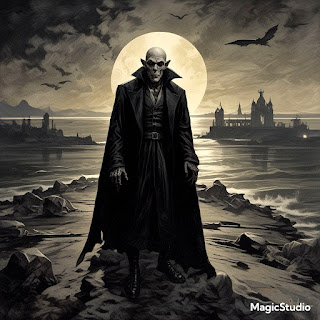Publicity
poster for Nosferatu the Vampyre - I've often thought that the immensely-gifted artist responsible for it should have created an entire animated movie version - what a spectacular-looking film that would have been! (©
Werner Herzog/Werner Herzog
Filmproduktion/20th Century Fox – reproduced here on a strictly
non-commercial Fair Use basis for educational/review purposes only)
On 28 May 2017, I watched the 1979 horror movie Nosferatu
the Vampyre – German film director (and writer) Werner Herzog's art-house
remake of the earlier German film director F.W. Murnau's classic 1922 silent German
Expressionist film Nosferatu: A Symphony
of Horror. This in turn was undeniably inspired by Bram Stoker's original 1897
novel Dracula.
Speaking which: in that
latter silent version, the vampire was actually named Count Orlok and a few
plot changes were also made, in order to avoid – unsuccessfully, as it proved –
being sued for copyright infringement by Bram Stoker's estate. (After Murnau lost
the court case, all copies of his movie were ordered to be destroyed, but
happily a few survived, which is why it still exists today.) In contrast, Stoker's
novel had entered the public domain by the time that work had begun on Herzog's
version, so the original name and plot could be used in this version.
The firat in a series of six Nosferatu-themed AI-generated images created by me using Magic Studio and included here
However, of particular note
is that Herzog faithfully reproduces the appearance of Dracula as conceived in
Murnau's movie and portrayed in it by Max Schreck. That is, not as the suave, cloak-swirling
seducer familiar from modern-day vampire films, whose fangs are extra-large upper
canine teeth, but rather as a hunched and hideous-looking monstrosity with huge
rat-like (or bat-like?) ears, excessively long, needle-like 1st upper
incisors, deathly pallor, and an overall albeit contradictory mien of living
decay.
As I expected from an
art-house film, Nosferatu the Vampyre
is visually stunning, but with the very notable exception of Klaus Kinski, who
is quite mesmerising in the title role. the acting is rather stilted and
laboured, and I confess to being somewhat mystified by certain aspects of the
plot. In particular, am I correct (or not) in assuming that the rats and the
plague are merely a cover created by Dracula to conceal his vampiric activity?
But if so, surely the death count is too high for even the most bloodthirsty
vampire to achieve? Conversely, if this is all a misapprehension on my part,
and the spreading of the plague via the rats was truly real and not a
subterfuge, what was the point of it? As far as I can remember (although a
great many years have passed since I read it), there is no rat-spreading plague
outbreak present in Stoker's original novel, even though it is included in both
Nosferatu movies.
Also, given that the physical appearance of Count Dracula in both movies is so grotesque, so unearthly, how could Jonathan Harker (renamed Thomas Hutter in Murnau's film) not realise instantly that his secretive Transylvanian host is indeed a member of the undead rather than merely a castle-bound eccentric?? Such plot-holes aside, however, and suspending disbelief in relation to them, Nosferatu the Vampyre is unquestionably a fascinating film, and yet another long-awaited one finally ticked off my list.
Indeed, ending this
mini-review on a heretical note: I personally consider that Herzog's version
is far superior to Murnau's silent original, in which I always find the Count
to be comical rather than creepy, humorous rather than horrifying, a totally
unbelievable entity no matter how much disbelief I strive to suspend when
watching him on screen.
Last but not least, and just in case you are wondering what it means and/or where it comes from: according to 19th-Century British authoress Emily Gerard's travelogue on Transylvania The Land Beyond the Forest (1888), 'Nosferatu' is apparently a Romanian word for 'vampire' (Transylvania itself translates as 'Beyond the Forest'). Consequently, the title of Herzog's film is actually tautological, translating as 'Vampire the vampire'!
And to view a complete listing of all of my
Shuker In MovieLand blog's other film reviews and articles (each one instantly
accessible via a direct clickable link), please click HERE!
Photo-still
from Murnau's 1922 silent movie Nosferatu:
A Symphony of Horror, showing the famous, iconic image of Count Orlok's
shadow as he climbs the stairs to seek out his intended victim (public domain)









No comments:
Post a Comment